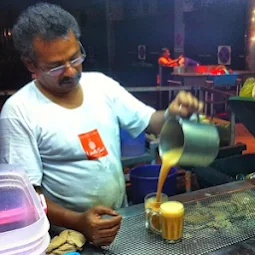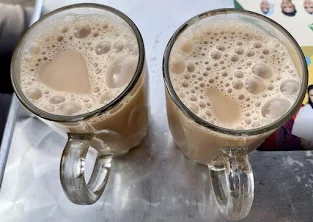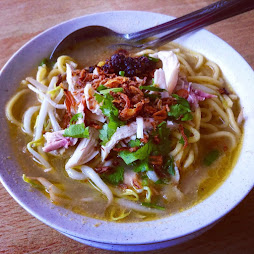Teh Tarik (Pulled tea) - A comfort afternoon tea
The calories rich but tasty teh tarik (or spelled as teh tarek) or pulled tea is a unique milk tea found in Malaysia and Singapore. It is made of black tea in combination with sweetened condensed milk (or evaporated milk for less sweetness, and tossing or dragging (tarik) the tea from one container to another at a height to create a frothy effect. This tea is usually drank while having roti prata. Well you can drink it with about any snacks or dishes or you can just sip it on its own as the teh tarik is like a dessert beverage by itself, full if sweetness from the condensed milk and sugar.
There is also teh masala or the spice tea, but for locals here we tend to stick with the simpler teh tarik. Masala tea may appeal more to Indians. At many local coffee shops, teh-C is a lingo used to mean tea with evaporated milk to differentiate from the concentrated condensed milk. The letter C actually stand for 'cair', a Malay word for diluted or unsweetened. That applies to kopi-C too.
The teh tarek stalls are traditionally owned or operated by Indians. A glass or a cup of teh tarik usually cost between $1.20 to $2.00 depending if you get them at hawker centres or air-conditioned food-courts or cafes. Obviously it is cheaper and tastes better at the road-side stalls or at hawker centres. We locals like to say it feels shiok having a cuppa of teh tarik. Some stall owners entertain you with their skill on how high they can tarik or pull the tea.
There is also teh masala or the spice tea, but for locals here we tend to stick with the simpler teh tarik. Masala tea may appeal more to Indians. At many local coffee shops, teh-C is a lingo used to mean tea with evaporated milk to differentiate from the concentrated condensed milk. The letter C actually stand for 'cair', a Malay word for diluted or unsweetened. That applies to kopi-C too.
The teh tarek stalls are traditionally owned or operated by Indians. A glass or a cup of teh tarik usually cost between $1.20 to $2.00 depending if you get them at hawker centres or air-conditioned food-courts or cafes. Obviously it is cheaper and tastes better at the road-side stalls or at hawker centres. We locals like to say it feels shiok having a cuppa of teh tarik. Some stall owners entertain you with their skill on how high they can tarik or pull the tea.
 |
| Teh tarik seller |
There is another variant of teh tarik, one that contains ginger. It is teh halia or ginger milk tea. Halia is a malay word for ginger. The term sarabat tea originally refers to teh halia, though it is commonly used to mean an Indian stall selling teh tarik thus the words are used interchangeably as a teh tarik stall that sells sarabat tea too. Ginger is believed to have some herbal effects and so is good for the stomach. With all the sugar and fatty condensed milk, ginger is supposed to balance the calories!
Teh tarik is typically consumed during the afternoon. Be aware that if you drink teh tarik late at night you may have problem sleeping after that as we all know tea contains caffeine and black tea used in teh tarik can be quite strong in that department. The tea traditionally used to make teh tarik is the tea dust type, but it can also come in tea-leaves. Personally I would avoid drinking teh tarik late in the evening but for some people it may be just fine.
A popular teh tarik stall is at Kampong Glam opposite Kampong Glam Cafe, which also serves a a nice cuppa of teh tarik with a great view of Bussorah Street as seen on the left photo, along Baghdad Street, with that stall has no name. So it is aptly named as no name teh tarek stall. No name but tasty and delicious teh tarik.
After many years with no name, this stall is now named as Bhai Sarabat stall. They advertised themselves as 'the best chai shop in Singapore'. "Chai' is a Hindi word meaning tea. You will usually find long queue at this stall.
The top photo shows how teh tarek is done. This photo is taken at the teh tarek roadside stall at Lau Pa Sat. Lau Pa Sat is an iconic hawker centre built a century ago and located in the heart of financial business district near Raffles Place MRT station.
During the evenings, you can find road-side stalls selling skewered meat satay. And this teh tarek stall is the one and only teh tarek stall there, as iconic as the hawker centre. Post note: I noticed this stall is now operated by another drink seller. Well, there goes history.
The word 'tarik' is also spelled as 'tarek', depending if one uses the newer or the older Malay spelling version. Do you know that teh tarek is an unofficial drink of Malaysia, our neighbouring country? Indeed teh tarik is enjoyed by both Singaporeans and Malaysians. Maybe it can be recognised by UNESCO as a shared cultural heritage just like the kebaya. How cool will that be.
Teh tarik is typically consumed during the afternoon. Be aware that if you drink teh tarik late at night you may have problem sleeping after that as we all know tea contains caffeine and black tea used in teh tarik can be quite strong in that department. The tea traditionally used to make teh tarik is the tea dust type, but it can also come in tea-leaves. Personally I would avoid drinking teh tarik late in the evening but for some people it may be just fine.
 |
| Frothy teh tarik and şarabat tea (they look alike) |
After many years with no name, this stall is now named as Bhai Sarabat stall. They advertised themselves as 'the best chai shop in Singapore'. "Chai' is a Hindi word meaning tea. You will usually find long queue at this stall.
 |
| Bhai Sarabat tea at Kampong Glam |
During the evenings, you can find road-side stalls selling skewered meat satay. And this teh tarek stall is the one and only teh tarek stall there, as iconic as the hawker centre. Post note: I noticed this stall is now operated by another drink seller. Well, there goes history.
The word 'tarik' is also spelled as 'tarek', depending if one uses the newer or the older Malay spelling version. Do you know that teh tarek is an unofficial drink of Malaysia, our neighbouring country? Indeed teh tarik is enjoyed by both Singaporeans and Malaysians. Maybe it can be recognised by UNESCO as a shared cultural heritage just like the kebaya. How cool will that be.



Comments
Post a Comment